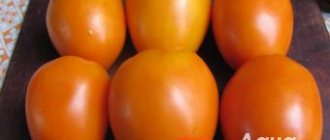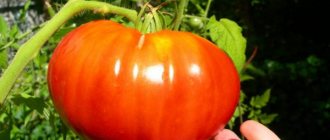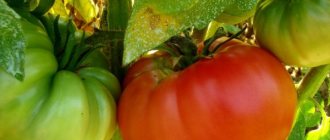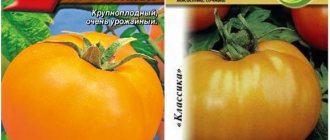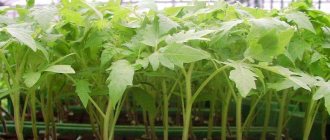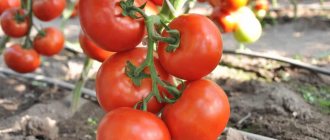Description of the variety
Tomato Tatyana is an early-ripening, unpretentious variety with high yield and pleasant taste. The ripening period is on average 80-100 days. The fruits have a flat-round shape, sometimes with slight ribbing at the stalk.
On average, a ripe tomato reaches 150 g, sometimes reaching 250 g. This is a good indicator for an early ripening variety. The Tatyana tomato variety has a fairly high yield - 5 kg of fruits per 1 sq. meters of planting even without careful care. What tomatoes look like Tatyana looks at the photo.
Origin of the tomato variety "Tatyana"
Tomatoes "Tatyana" were bred by Russian breeding scientists. The main purpose of tomatoes is growing in open ground.
Description of the variety
Tomatoes of the review variety are a determinate standard plant with a height of about 60 cm. A distinctive feature of tomatoes is early ripening and very high yield. An abundant green mass is formed on a strong stem. Dark green leaves of medium size, fruits ripen in clusters in quantities of 3 to 5 pieces.
Characteristics of the fruits of the Tatyana variety
- Medium sizes;
- The weight of ripe tomatoes ranges from 120 to 200 grams;
- Flat-round shape;
- Noticeable ribbing near the stalk;
- Thin glossy skin;
- Fleshy and juicy pulp;
- A small number of seeds;
- The fruits do not crack;
- High solids content;
- Rich, sweet and fruity taste.
Growing
When using the greenhouse method or when growing tomatoes in a warm climate, it is best to sow the Tatyana tomato in early spring. In the conditions of the Urals, Siberia and the Far East, it is worth waiting for the average air temperature to reach about 20°C. Before sowing the seeds, they can be pre-soaked, which will speed up the germination process.
For successful germination, it is recommended to use special soil for seedlings. The seeds are moistened with water and dropped a couple of centimeters into the nursery. Do not forget about watering the tomatoes, as well as the first fertilizing with diluted fertilizer, when the plants have their first full-fledged leaves.
Landing in the ground
Grown and strengthened seedlings can be transplanted into the ground after two months. If you have a greenhouse, one month will be enough. Given the unpretentious nature of the Tatyana tomato, almost any soil is suitable for its cultivation. When transplanting into the ground, do not forget that per 1 sq. There should be no more than six plants per meter of seedlings. The soil is pre-loosened and moistened.
Tatyana tomatoes do not require pinching or tying; it is enough to remove the lowest leaves from the bushes. Tomatoes are fed 3-4 times during the summer season. Fertilizers can be both mineral (phosphorus-potassium fertilizers are best suited) and organic origin (humus, compost, manure).
You should be careful with nitrogen supplements, as they can slow down the ripening of fruits. Water the seedlings once a week; on hot days it is worth increasing watering to once every five days. It is best to water the plants early in the morning using warm water, then lightly loosen the soil.
Tatyana does not require special growing conditions, but mulching is highly recommended. It speeds up ripening by a week, increases yield by 30%, and most importantly, protects plants from the harmful effects of the external environment and pests.
Mulch can be either organic (hay, grass, pine branches) or inorganic (polyethylene, roofing felt). You can also use waste paper and cardboard for mulching. The mulch is spread evenly between the bushes at the end of May.
Tomatoes of the Tatyana variety have bred resistance to major diseases. They ripen before the main enemy of all summer residents, late blight, appears. The main pests are Colorado potato beetles, aphids, and mole crickets. To combat them, wipe tomatoes with a weak solution of ammonia.
Features of agricultural technology
The seedlings are ready for transplanting in 55-60 days. Bushes are planted in fertilized heated soil at a distance of 40 cm. The holes are made 20 cm deep.
What guidelines do agricultural techniques provide for increasing productivity:
- Watering is balanced at the roots.
- Fertilize 2 times a month using organic matter and a phosphorus-potassium mixture.
- Foliar feeding is used.
- The beds are loosened regularly or mulched with hay in a layer of at least 8 cm.
The variety does without pinching. The bushes are tied up at your discretion.
All activities during planting and care will not cause any special difficulties. It is enough to follow all basic agricultural practices.
Growing seedlings
Tomatoes are grown in seedlings, familiar to all other varieties of tomatoes. It is important to purchase quality seeds. Next, treat with a growth stimulator and plant in containers with nutrient soil mixture at a distance of 2 cm from each other.
Next, the soil is moistened and covered with film or glass, placed in a dark and warm place until seedlings appear. It is necessary to sometimes ventilate and spray the soil.
When 2 adult leaves appear, the seedlings are planted, that is, planted in separate plastic cups or peat pots. Can be moved to a sunny place. Water and feed regularly. The variety has strong immunity, so the sprouts tolerate picking well and immediately begin to actively grow and develop.
Before planting in open ground (7 days in advance), carry out the hardening procedure: take the seedlings outside for an increasingly longer period of time every day until they remain in the fresh air for the whole day.
- If you grow in a greenhouse, you should ventilate it quite often so that a sufficient amount of air penetrates to the plants. Despite the variety’s resistance to viruses and diseases, you should not maintain dampness or very high humidity levels.
- If there are a lot of fruits, then you can tie up the plant so that the stems do not crack or break. There is no need to stepchild. When planting, make sure the ground has warmed up and the night frosts have gone away. If cold weather sets in, cover the seedlings with film.
- The most acceptable dates: from the third ten days of May to mid-June. The gap between seedlings must be at least 30 cm.
- Prepare the area before planting seedlings in open soil. Follow the rule of crop rotation: crops of the Solanaceae family, including tomatoes of other varieties, should not be grown in front of tomatoes.
- The acidity level should be low or neutral. Add compost and wood ash to the soil. To obtain a more abundant harvest in the future, plant plants in sunny, dry areas where groundwater does not flow too close to the soil surface.
- Be sure to water the bushes on time. This variety loves frequent but moderate watering. Water the plants once a week if the weather is not too hot. During periods of heat and drought, moisten the soil more often.
- It is recommended to feed according to the schedule, like all other varieties of tomatoes. This must be done at least 5 times throughout the entire season.
- Experienced gardeners recommend alternating different types of fertilizers: first, organic; during the period of tassel tying and flowering, it is advisable to use potassium and phosphorus. During the fruiting period, use complex preparations. It is important to know the composition of the soil in a particular area, and, based on this, select the desired composition of fertilizers.
- A mandatory procedure is loosening and mulching. It is necessary to remove weeds so that they do not take nutrients from the plants.
- You can mulch with sawdust, compost, peat. This way moisture is retained for a longer period.
Most often, the Tatyana tomato is grown by obtaining seedlings.
Seedling
For seedlings, soil is required, which is a mixture of humus and turf soil in equal quantities. It is allowed to purchase soil intended for vegetable crops.
Important! Seeds germinate best if planted in coconut substrate or peat pots.
The soil should be heat treated two weeks before planting. To do this, you need to place it in the oven for 15 minutes.
Seeds also require certain processing. They will need to be placed in a solution of 100 ml of water and 1 g of salt for a day.
Seeds are planted to a depth of no more than 1 cm with an interval of 2 cm. Fresh planting is sprinkled with soil, after which it is thoroughly watered.
Transplanting into a greenhouse
You can transplant seedlings of the Tatyana tomato variety into a greenhouse approximately two months after the first shoots appear. By that time, the height of the shoots reaches about 20 cm, has several full leaves and a fairly developed root system.
The best greenhouse for tomatoes is made of glass or polycarbonate. It is important to dig up the soil under the plant in the fall and remove the top layer of soil. The latter action will significantly reduce the likelihood of developing most diseases and the spread of harmful insects.
The soil should be fertilized with compost, superphosphate, and potassium sulphide.
Important! Mineral fertilizers should be applied at a rate of no more than 20 g per square meter. m.
Planting in the greenhouse is done to a depth of 20 cm. The distance between rows should be about 0.7 m, and between plants - 0.5 m.
Tanya tomatoes, in accordance with the description, should be planted in a well-lit area that is reliably protected from the winds. Planting in open ground should begin after the spring frosts have ended. The soil is prepared in the fall: it is dug up and fertilized with humus.
Planting is done in shallow holes (15-20 cm) with an interval of 40 cm between plants. After planting, the seedlings are covered with soil, lightly compacted and watered thoroughly.
The Tatyana variety is quite unpretentious in care. To get a decent yield, it is enough to regularly water and periodically feed the plant.
To increase the stability indicator, the crop is tied to a support.
The plant requires moderate watering. With a lack of moisture, the leaves of the crop begin to curl strongly and the ovaries fall off. Excessive moisture causes no less harm to Tatyana’s tomatoes. In this case, the plant begins to slow down its growth, and fungal diseases begin to actively develop on it.
3-5 liters of water are usually sufficient per bush. The variety needs to be watered 1-2 times a week. This should be done early in the morning or in the evening after sunset.
Important! Tatyana tomatoes require fertilizing almost weekly. Phosphorus and potassium fertilizers are best suited for the crop. The former promote the development of plants, accelerate their metabolism, and also increase immunity. The latter improve the taste characteristics of the fruit.
Among the traditional methods of feeding, you can use ordinary ash. It is added directly under the plants. As an option, it is allowed to use an infusion for watering. To prepare the composition you will need 2 kg of ash per 10-liter bucket of hot water. The mixture is infused for 24 hours.
Tomato feeding
Despite the short stature of the bush, Tanya tomatoes require garter and support. This allows the stem to remain straight and the fruits not to fall to the ground. In addition to the above, after gartering the plant becomes much easier to care for.
Wooden or steel supports are usually used for garters. For extensive plantings, it is allowed to use trellises with tensioned wire at a height of 50 cm.
Advantages and disadvantages of the variety
The Tatyana variety has many advantages. Its unpretentiousness allows you to grow tomatoes even in unfavorable climatic conditions, and the resistance to all major diseases developed by breeders makes caring for seedlings much easier. Tatyana is an early ripening variety that does not require pinching or tying, which makes these tomatoes an ideal option for those summer residents who cannot afford to stay on the plot all season.
Another very important advantage is that this variety is not an F1 hybrid. This means that you yourself can select the seeds of the best fruits and not buy new seeds for next year.
The disadvantages of some farmers include the small size of the fruits, which is fully compensated by their quantity due to the good yield of the variety.
Diseases and pests
Despite the excellent immunity of the tomato hybrid "Tanya", it is still worth carrying out preventive measures, spraying with the preparations "Profit", "Oxyx", infusion of onion and garlic peels with the addition of potassium permanganate. If the tomato bushes are still affected by the disease, they are sprayed with the drug “Fitosporin”.
Preventive spraying with a decoction of celandine, chamomile or soap solution, as well as regular weeding, help keep pest infestation under control. The variety rarely gets sick. Sometimes leaf curling occurs. This can be caused by harmful bacteria, which are eliminated with a pale pink solution of potassium permanganate, or by improper, uneven watering.
The Tatyana variety is resistant to a large number of dangerous diseases that affect vegetable crops of the nightshade family.
Tomatoes are not afraid of diseases such as:
- Verticillium;
- Spotted Mosaic;
- Fusarium.
For preventive purposes, the area with tomatoes is treated with preparations that contain copper.
To protect plantings from fungi, proper watering and mulching of the soil in the beds with peat or humus is necessary.
It is useful to treat young bushes with phytosporin or a weak solution of potassium permanganate.
Preliminary preparation of the soil will help protect Tatyana tomatoes from viruses - treating them with a solution of copper sulfate or calcining the top layer at a high temperature.
REFERENCE: Early ripening of tomatoes makes it possible to avoid the appearance of late blight.
Insects and pests that can threaten tomatoes of the review variety:
- Colorado beetle;
- Thrips;
- Whitefly;
- Aphid;
- Slugs;
- Medvedka.
Spraying the area with tomatoes with soapy water will help get rid of aphids. Whiteflies and thrips are afraid of celandine decoction. Colorado beetles and larvae are usually collected by hand.
Mulching the soil will protect plants from slugs and mole crickets.
In case of pest infestation, special insecticides should be used.
Bush care
The basic rules for caring for plants are as follows:
- Regular watering with settled soft water;
- Loosening the soil on the site;
- Mulching beds with peat, straw or humus;
- Weed removal;
- Fertilizing 3-4 times per season with complex mineral fertilizers and organic matter.
There is no need to pin and tie up tomato bushes. Experienced vegetable growers recommend removing the lower leaves to improve air exchange.
Tomato Tatyana
Description and characteristics of the tomato variety Tatyana, reviews, photos
Early ripening (93-102 days from germination to ripening), determinate, low-growing, unpretentious, productive tomato variety for open ground and film shelters.
The bush is standard, heavily leafed, 0.5-0.6 meters high, does not require pinching. Medium sized leaf, green. The inflorescence is simple. The first inflorescence is laid above the 6-7 leaf, the subsequent ones - every 1-2 leaves.
Basic qualities of fruits
The fruits are flat-round, slightly ribbed at the stalk, red in color at maturity, weighing 100-150 grams (up to 250 g), fleshy, good (for early varieties) taste. These tomatoes are used both for fresh consumption and for processing.
Productivity : 4.7-5.1 kg of fruits per 1 sq. meters of plantings (with proper agricultural technology).
Planting pattern : 50 x 40 cm, planting density: up to 6 plants per 1 sq. m.
Advantages of the variety : high yield, early ripening, all-weather.
Thanks to its early ripening, this tomato “escapes” late blight.
Tomato Tatyana is included in the State. register for the Russian Federation for garden plots, household plots and small farms for cultivation in open ground.
If you grew Tatyana tomatoes, please write whether you liked them or not. What was the yield and taste of the fruits like under your climatic conditions? Briefly describe the advantages and disadvantages of this tomato in your opinion, and evaluate its taste. If possible, attach a photo of the entire bush or individual fruits you grew to your comment. Thank you!
Your reviews of the Tatyana tomato and additions to the description will help many gardeners evaluate this variety more objectively and decide whether it is worth planting or not.
Reviews
Lyudmila. “This apple tree variety has been growing on my site for several years. It has high winter hardiness. Apples are tasty and juicy. They are stored for a long time. If all rules are followed, apples can be stored for up to 5 months. This is one of the advantages of the variety.”
Anastasia. “This year I planted an apple tree of this variety for the first time. I read a lot of positive reviews about the variety. They write that the yield is high, has good winter hardiness and very tasty fruits. I'm looking forward to a good harvest."
Maksim. “The Tatyana variety is a new and very good variety. Winter hardiness at a high level. In severe winters it can get small frost damage, but in the spring it quickly recovers and grows quickly. The fruit size and weight are good. The average fruit weight varies from 100 to 110 centimeters. The taste is excellent. I recommend to everyone."
The nuances of growing in open ground and in a greenhouse
The hybrid is recommended for breeding throughout the country. In southern regions and regions with temperate climates, tomatoes are planted in open ground. In those areas where it is cold for a long time, the crop can only take root in greenhouses.
Tomato beds are chosen in a sunny place, protected from drafts. If the summer turns out to be cool, you need to have covering material on hand. Otherwise, the prolonged influence of negative weather factors will lead to a decrease in yield.
Since tomato branches are spreading, in protected structures it is recommended to leave a larger distance between seedlings when planting to avoid crowding. Greenhouse plants are most likely to suffer from mold due to increased humidity and air temperature. Therefore, the greenhouse must be regularly ventilated to avoid fungal diseases.
Spider mites are another scourge of the greenhouse. To protect against it, ventilate the greenhouse regularly.

